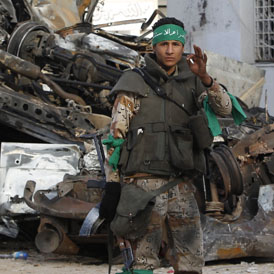‘No move zone’ required to stop Gaddafi
As Colonel Gaddafi forces retake key towns in Libya, including Brega, defence analyst Anthony Tucker-Jones looks at the military options and how Libya’s leader has bounced back this week.

Following the popular rising losing momentum in Libya, Colonel Gaddafi now finds himself fighting a three front war. On the ground his loyalist forces have wrestled back control of Zawiya to the west of Tripoli and Ras Lanuf to the east. Internationally he is waging a ‘soft war’ or media war, in an effort to convince the world he is resisting an al-Qaeda inspired revolt and that his regime’s legitimacy remains.
Gaddafi’s fortunes have experienced a remarkable turnaround, in the past week he has gone from the very brink of being ousted, to holding all the cards. On paper his loyalist forces are well equipped and have shown a growing willingness to fight. In contrast there are complaints from the opposition ranks that military personnel who have crossed over have shown little appetite for resisting their former paymasters.
Courage alone will not stave off determined attacks by these 45-ton monsters
The Libyan armed forces inventory includes a plethora of largely aging Soviet era weapons. Nonetheless in semi-capable hands against ill-equipped and ill-trained opposition forces these will be more than up to the job. While Gaddafi initially resorted to relying on tribal levies and mercenaries there are increasing indications that the bulk of the armed forces have remained loyal.
Tanks have paraded in the streets of Tripoli in a show of strength. These are believed to belong to the Khamis 32nd Brigade, which can probably muster a single tank and mechanised regiment for offensive operations.
Jonathan Rugman blogs on the retaking of Zawiyah from rebel hands:
"Old men averted their frightened eyes when I approached them to ask them what had happened, and whether the macabre scenes of jubilation reflected what people really felt.
"And most shockingly of all, the graves of 20 rebel fighters scattered amid the trees and benches of a little park had been flattened with bulldozers and covered with builders' sand.
"I saw the tracks the bulldozers had left behind. And I know there were 20 graves, because I counted them last weekend, when Zawiyah was still in rebel hands.
"Those rebels have now vanished. The hospital where we filmed a week ago, full of men close to death from the fighting, is now a no-go zone under the army's control..."
Read more: Rebel graves bulldozed over in Zawiyah
On paper Gaddafi has almost 3,000 tanks, armoured infantry fighting vehicles and self-propelled guns, essentially enough for 10 armoured divisions, but only has manpower to operate a fraction of these.
His most modern tank is the aging T-72, but courage alone will not stave off determined attacks by these 45-ton monsters.
Similarly he has a considerable array of jet fighters, numbering over 400 combat aircraft, but few competent pilots to fly them. Gaddafi though has little need of his fighters, his key assets are the air force’s ground attack aircraft, which include MiG-23, Mirage and Su-22, and his Mi-24 Hind helicopter gunships.
The Su-22 has been used to attack Ajdabiya and Ras Lanuf. Such bombing raids were initially inaccurate and half-hearted, but are growing in intensity. It is quite probable mercenaries have conducted some raids; Zimbabwe is believed to have provided a few pilots who could be acting as a force multiplier. On Libya’s exposed coastal roads opposition convoys remain very vulnerable to air attack.
Time is of the essence before ammunition stocks become an issue.
Gaddafi knows he needs to swiftly regain control of the border with Tunisia to cut the opposition off in the west of the country.
Gaddafi knows he needs to swiftly regain control of the border with Tunisia to cut the opposition off in the west of the country. After securing Zawiya and Ras Lanuf he can draw a firm line in the sand and then commence a vigorous campaign of roll back towards Bengahzi. In preparation for this the air force has been conducting increasing air raids in an effort to destroy weapons dumps in opposition hands in the Benghazi area.
Without greater assistance from the Libyan armed forces the opposition’s options remain very limited. Small arms, rocket-propelled grenades, anti-aircraft guns and ‘technicals’ (pickup trucks fitted with weapons) are no match for tanks, heavy artillery, rocket launchers and bombs.
Opposition fighters have been seen with SA-7 manportable surface-to-air missiles, but it is unclear if they are operational and it is not a user-friendly weapon. Lack of organisation and command structure could prove the opposition’s greatest enemy.
The international community needs to recognise the opposition’s National Libyan Council as the legal representatives of Libya – as France has done, otherwise they will lose heart and feel abandoned in their uneven struggle.
Ultimately a No-Fly zone will not help the opposition fend off or defeat Gaddafi’s loyalist ground forces counterattacks. Tougher action is needed including surgical air strikes against key military targets, but international agreement for such aggressive action is unlikely to be forthcoming.
A No-Move Zone is what the opposition needs if their gains are to be safeguarded. Meanwhile Gaddafi plots his next military move.
Anthony Tucker-Jones is author of ‘The Rise of Militant Islam’
-
Latest news
-
NHS perinatal staff ‘exhausted, on their knees’, says maternity safety expert4m

-
Ex-Trump lawyer Michael Cohen testifies at hush money trial3m

-
Racial hate speech laws being ‘weaponised’ warns National Black Police Association7m

-
‘Hard to believe so many women going through such horrors’, says woman whose baby daughter was stillborn8m

-
Damning report condemns ‘shockingly poor’ UK maternity services12m

-




